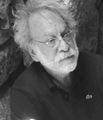He was born in 1945, in Athens. He studied painting at the Athens School of Fine Arts (1968-1970) with Nikos Nikolaou and continued his studies in Rome, at the Accademia di Belle Arti (1970-1974) and at the École Spéciale d'Architecture in Paris (1976-1980).
His first solo exhibitions in Greece (Desmos gallery, 1972, and Ora gallery, 1973) involving constructions and artistic actions, are organized in the context of the political unrest of the dictatorship and the similar avant-garde (and often provocative) art events of the era. Around the same time, he begins his interventions in public spaces, in various european cities (Plastic Actions in space).
His work includes references to cultural and mythical symbols of various eras, which stress the multiple dimensions of the artistic action over time. In the ‘80s, he begins his Concealments series; ritual actions in various parts of the globe, in public or interior spaces, e.g. galleries, museums, etc., where his works (usually large installations) are placed underground, thus making a comment on the meaning of time and memory. Up to now, more than 170 Concealments have been completed worldwide.
Additionaly, his Collaborations with Other Cultures project, an intercultural approach to cultures, religions and people, through which, artwork meets daily life and religious ritual, has been in progress since 1993.
He has represented Greece in international events, such as: The Young Artists Biennale of Paris (1980), the Biennales of Sao Paolo (1983) and Istanbul (1989), as well as the 1997 Biennale of Venice (along with Stephen Antonakos, Alexandros Psychoulis and Thanassis Totsikas), where he created a Concealment within the Greek pavilion’s precincts. He has written articles on art, as well as four books of literature.
He has been invited as an artist-researcher by the Center for the Study of World Religions of Harvard University, the Syracuse University-Syracuse N.Y, the Savannah College for Art and Design-Georgia, the Accademia di Belle Arti-Bologna, et al. He is an art consultant at the U.S. Fetzer Institute, since 2010.
Alithinos Dimitris (1945)





